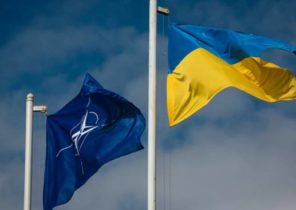
In response to the American Third compensation strategy, Russia has set itself the priority task of developing tactical and strategic nuclear weapons. This is stated in a new report, the Institute of defence and strategic studies (Institute of Defence and Strategic Studies) at the Singapore School for international studies. S. Rajaratnam. But while the Kremlin has focused on the creation of new models of nuclear weapons in the face of increasing conventional arms race, Moscow has also introduced military innovations, although on a lesser scale.
“The Russian response to these initiatives consists of two main elements. The first element is the opposition to the Third compensation strategy, the First compensatory strategies, which means the priority development of strategic and tactical nuclear weapons, — writes the Professor of the Institute of defence and strategic studies Michael rusk (Michael Raska) and leading researcher of Institute of Far East of the Russian Academy of Sciences Vasily Kashin. — Russia, with a modern Arsenal of nuclear weapons can effectively counter the innovations of the United States, NATO and China in the field of conventional arms. The second element is more ambitious and entails more technical risk. Russia has started to create a counterweight to the many technical initiatives of the United States, developing similar local programs, which, however, are smaller and have a more narrow specialization.”
Russia is pursuing an extensive modernization of its nuclear Arsenal by implementing a series of programs designed to create a counterweight to the American missile defense system, which is formed in Europe. “Russia deploys new ICBM RS-24 “YARS” and introduces operational submarines of project 955 “Borey” with missiles RSM-56 “Bulava”, the authors write. But at the same time it is developing at least two new families of Intercontinental ballistic missiles: heavy solid-propellant ICBMs “Sarmat” (RS-28) and a mobile solid-fuel missile complex “Rubezh” (RS-26), which are designed specifically for the destruction of the prospective us missile shield in Europe. Further, Russia provides its hypersonic ICBM warheads. And she carries out an ambitious program to create a modernized version of the strategic bomber Tu-160, which will be built in Kazan. Moscow very seriously any potential threat, reduce the effectiveness of Russian nuclear forces, and immediately begins to take countermeasures”.
In addition, Russia is modernizing its tactical nuclear force composed of ballistic short-range missiles, nuclear gravity bombs, cruise missiles and even anti-aircraft missiles with nuclear warheads. “In short, the Russian program aimed at upgrading nuclear forces, are at an advanced stage, write the rusk and Kashin. — Russia already has a significant advantage over the United States in terms of the quality and diversity of delivery systems, and is able to reliably ensure the strategic effectiveness of its nuclear forces in the near future.”
However, Russia has not abandoned conventional weapons and conducts research about along the same lines as the United States, forming its response to the American Third compensation strategy. But the scale of such activities is limited due to lack of resources. “Russian technologies in some areas are at an early stage of development, the authors write. But in other areas, such as energy directed energy weapons, railguns, hypersonic aircraft, underwater uninhabited vehicles, it is moving forward very successfully”.
In the long term Russian, most likely, will focus on the creation of the following equipment:
— Robotic systems with remote control, including UAVs, as well as machines for land forces, which are currently undergoing a serious test. It’s combat and reconnaissance vehicles, and vehicle logistics and support.
A new generation of electronic warfare systems, and tools for conducting cyber warfare with improved characteristics.
— Implementation of advanced control systems, including the Internet on the battlefield.
— Modern systems of air and missile defense high and extra range with the capabilities of anti-satellite combat, which will be used not only in defense, but also for superiority in the air. Thus, Russia can take advantage of its Western opponents.
— Well-protected armored vehicles of the new generation, which will significantly reduce losses in local conflicts.
Modern fighters, capable to resist Western aircraft of the fifth generation.
— Hypersonic weapons as the main means of destruction and missile systems of the future.
— Program to create energy weapons directed action, designed to lay the groundwork for the development of advanced weapons systems.
Remarkably, this list does not include projects such as the giant destroyer with a nuclear power plant of the type “Leader” and the new aircraft carriers. The thing of it is. Although the Kremlin state media very often lead a very strange and ridiculous propaganda in the Russian professional journals provides accurate information about the strategy of Moscow. Meanwhile, Western analysts and media in General ignore such information — perhaps because of the language barrier.
“It is important to understand the differences between Russian defense policy, draw mainstream media in this country, defense policy in the views of the West and genuine defense policy of Russia, the authors write. Three of these phenomena exist mainly in three different universes and almost touching. Military technology and military construction, which in reality will shape the future of the Russian army and the nature of the strategic balance in the Russian geographical environment, almost never secret. They are detailed and well described in the statements of the military command of Russia and in professional journals, where are the Russian military experts. However, leading Russian mass media rarely pay attention and attach importance to such programs, and instead have the habit of writing about loud, but unrealistic concepts to create weapons. The West too often ignores, preferring to portray Russia as a sort of growing world power, which on all fronts and throughout the world challenges the US and the West”.
In the end, the Kremlin seems to be doing very sensible and reasonable strategy, taking into account technical and material resources of Russia.
Dave Majumdar is editor of the National Interest, covering military issues.







